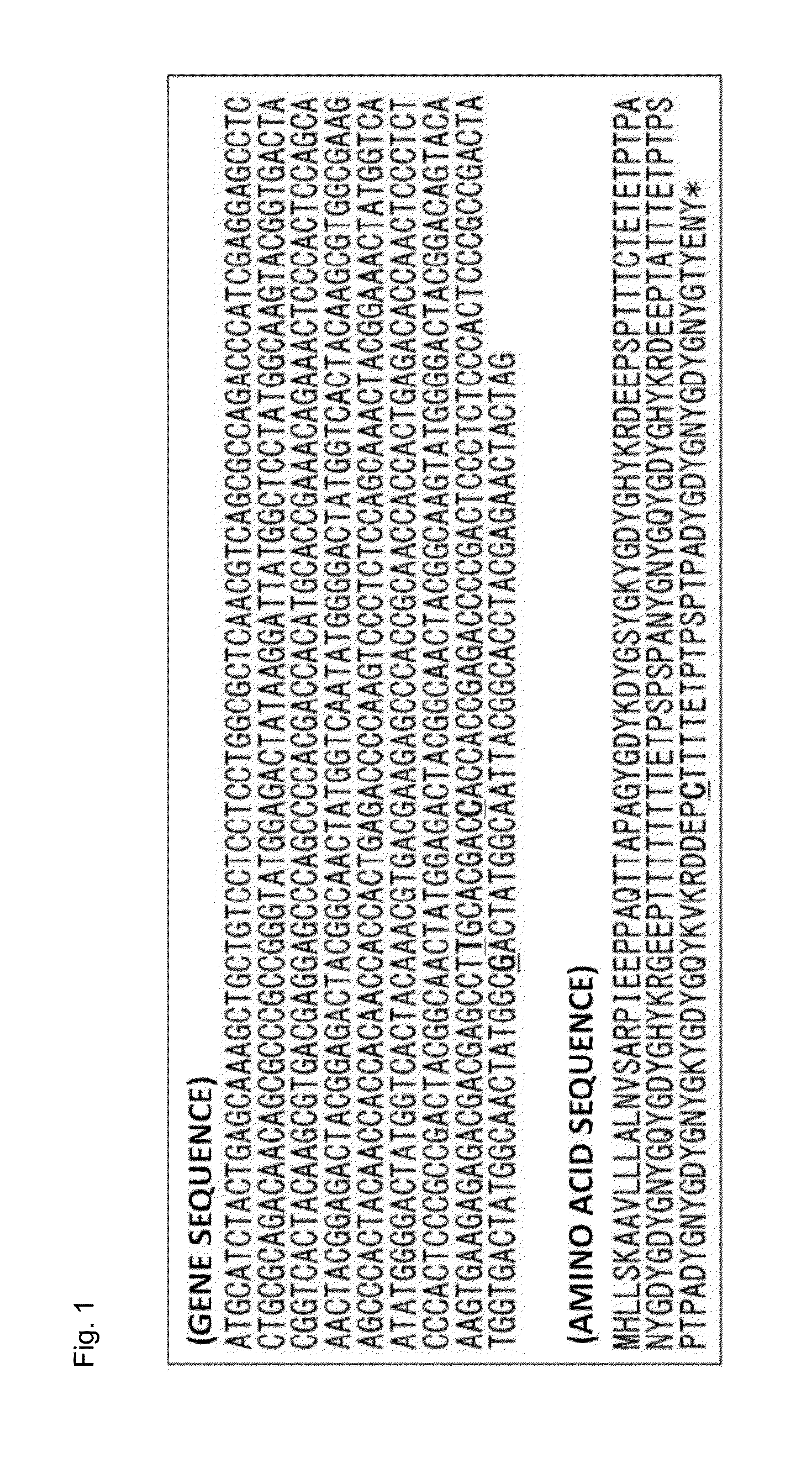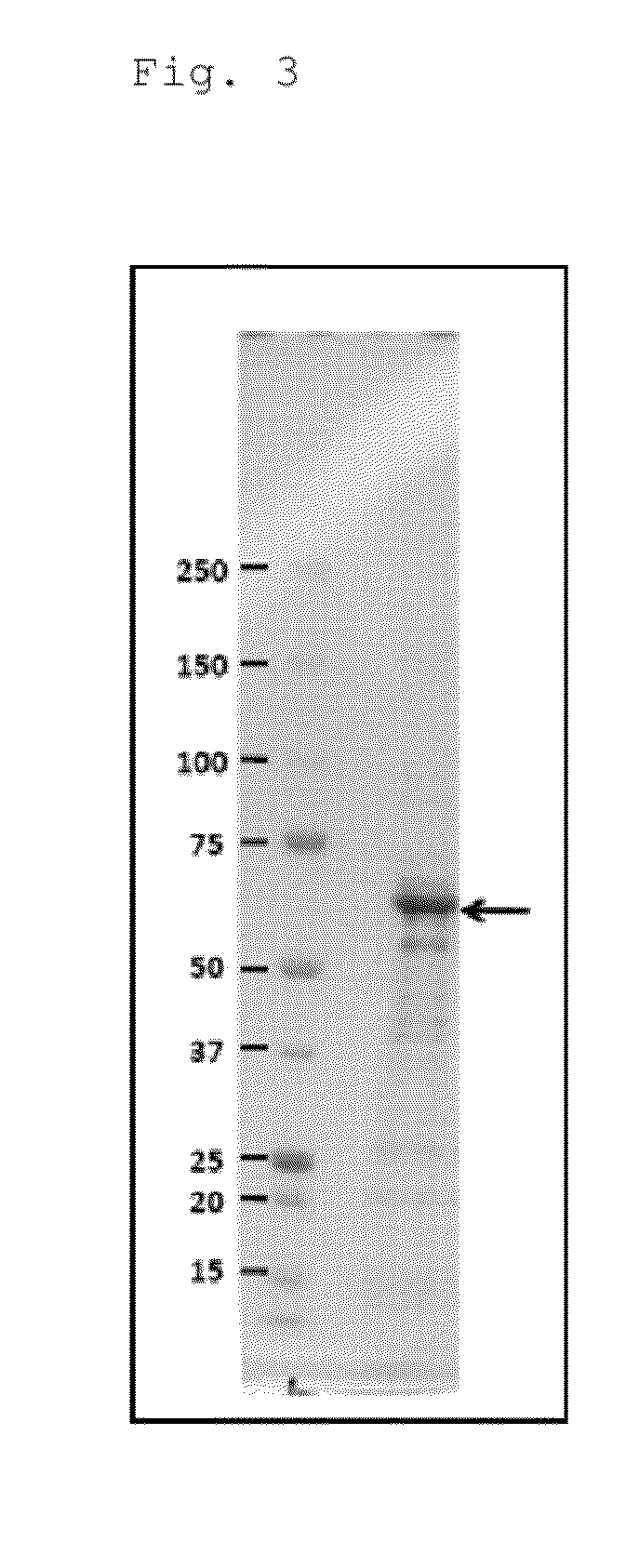Methods and composition for testing, preventing, and treating aspergillus fumigatus infection
a technology of aspergillus fumigatus and composition, which is applied in the field of methods for testing, preventing and treating an aspergillus fumigatus infection, can solve the problems of low sensitivity and specificity for other underlying diseases, unable to always have satisfactory detection specificity and detection sensitivity, etc., and achieves high specificity and sensitivity
- Summary
- Abstract
- Description
- Claims
- Application Information
AI Technical Summary
Benefits of technology
Problems solved by technology
Method used
Image
Examples
example 1
Executing SST-REX
[0157]SST-REX was executed to comprehensively obtain information on a gene encoding a membrane protein or a secretory protein expressed on the cell surface of Aspergillus fumigatus.
[0158](1) Preparation of cDNAs
[0159]Conidia of a clinically isolated strain MF-13 of Aspergillus fumigatus were cultured in a YPD medium at 37° C. for 3 days. Mycelia were formed from the conidia by the culturing, and the mycelia were further grown into a filamentous form with a diameter of approximately 5 to 10 mm. Then, after Aspergillus fumigatus was collected, total RNA was prepared from the fungus. Subsequently, 12 μg of mRNAs were obtained from the total RNA as the material using FastTrack2.0 mRNA Isolation kit (manufactured by Invitrogen Corp., #K1593-02). Thereafter, using SuperScript™ Choice System (manufactured by Invitrogen Corp., #18090-019), double-stranded cDNAs were prepared from 3 μg of the obtained mRNAs.
[0160](2) Incorporation (Chimerization) of cDNA Sequence e into pMX...
example 2
Cloning of YMAF1 Gene and Construction of Expression System
[0178](1) Identification and Cloning of Expressed Gene
[0179]Genes corresponding to the genes obtained by the SST-REX method in Example 1 and believed to encode a secretory protein or a membrane protein were identified from annotation information described in the genome database of Aspergillus fumigatus, and so forth. The functions of many of the identified genes were unknown from the information in the database. Nevertheless, in consideration of the number of the SST clones containing the genes thus obtained, targeted was a gene YMAF1 (YPD medium associated major antigen of Aspergillus fumigatus, SST clone cell code: ACT073-502), which was shared by the largest number of the SST clone cells containing the gene, and which was believed to have a high level of expression.
[0180]The YMAF1 gene is a gene encoding a conserved hypothetical protein having a molecular weight of approximately 23 KDa based on the database. According to ...
example 3
Preparation of YMAF1 Antibody
[0187](1) Polyclonal Antibody
[0188]The vector described in Example 2 (3), in which the YMAF1 gene was cloned, was introduced into Escherichia coli BL21, and the recombinant protein was excessively expressed, followed by purification. Specifically, 100 mL of an LB medium was put into a 1-L Erlenmeyer flask, and 1 / 100 of the culture solution cultured above was further added, followed by shaking culture at 37° C. Then, when 0. D. 600=0.7, IPTG was put into the culture solution to a final concentration of 1 mM, and the mixture was further shake-cultured at 37° C. for 3 hours. Subsequently, approximately 2 mL of a Tris-HCl buffer (pH 7.5) was added to the resulting Escherichia coli cells, and sonication was performed on ice to prevent over-heating. Then, the resulting pellets were washed with a Tris-HCl buffer of the same formula as above, and subjected to sonication again. This operation was repeated three times to concentrate the recombinant protein. Therea...
PUM
| Property | Measurement | Unit |
|---|---|---|
| pH | aaaaa | aaaaa |
| pH | aaaaa | aaaaa |
| diameter | aaaaa | aaaaa |
Abstract
Description
Claims
Application Information
 Login to View More
Login to View More - R&D
- Intellectual Property
- Life Sciences
- Materials
- Tech Scout
- Unparalleled Data Quality
- Higher Quality Content
- 60% Fewer Hallucinations
Browse by: Latest US Patents, China's latest patents, Technical Efficacy Thesaurus, Application Domain, Technology Topic, Popular Technical Reports.
© 2025 PatSnap. All rights reserved.Legal|Privacy policy|Modern Slavery Act Transparency Statement|Sitemap|About US| Contact US: help@patsnap.com



